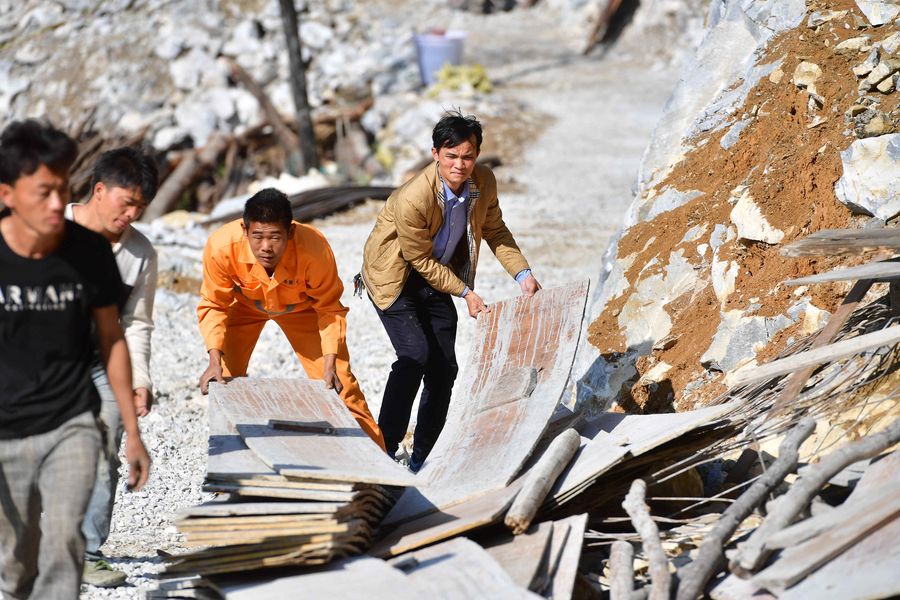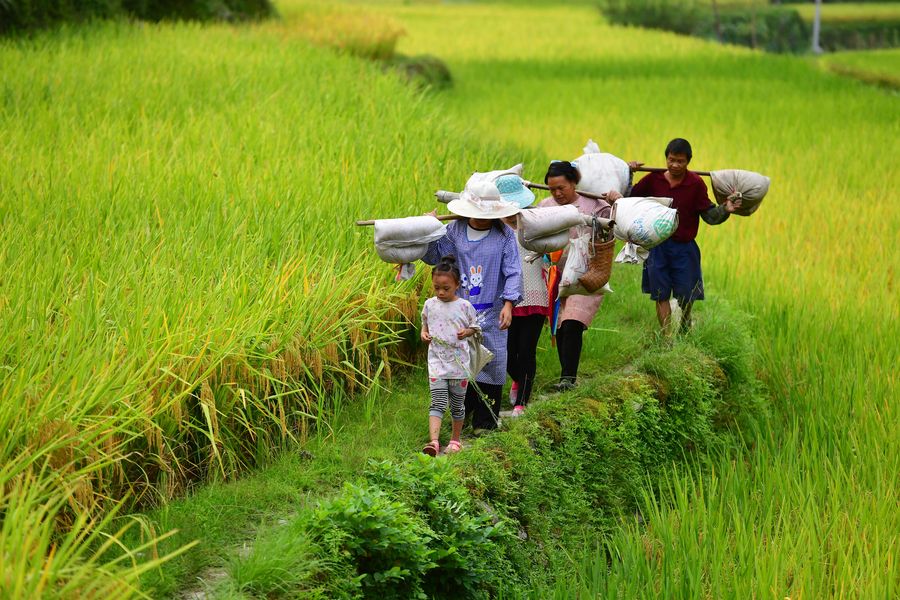China sounds clarion call to making absolute poverty history
Xinhua,January 10, 2020 Adjust font size:

A village Party member helps carry wood boards to build water tanks in Bahao Village, Dahua Yao Autonomous County of Guangxi Zhuang Autonomous Region, Dec. 16, 2019. (Xinhua/Huang Xiaobang)
In its fight against absolute poverty, the government is helping people get rid of poverty in more precise ways.
China is poised to tackle the hardest phase in securing a full victory in the anti-poverty battle in 2020 as it enters the homestretch in achieving the first centenary goal of building a moderately prosperous society in all respects.
The clarion has sounded and the battle against poverty will not stop until complete victory is secured. Chinese leadership has repeatedly underscored its resolve to bring the whole population out of absolute poverty, which has plagued the Chinese nation for thousands of years.
In its fight against absolute poverty, the government is helping people get rid of poverty in more precise ways.
POVERTY REDUCTION ACHIEVEMENT
In 2019, more than 10 million people and around 340 counties were expected to shake off poverty, the latest evidence that China will not leave a single family behind on the way to a moderately prosperous society in all respects.
The "three regions and three prefectures," which include Tibet Autonomous Region, southern parts of Xinjiang Uygur Autonomous Region and Linxia Hui Autonomous Prefecture in Gansu Province, were regarded as the hardest nuts to crack in the poverty reduction campaign.
There will not be a moderately prosperous society in all respects without poverty reduction success in such regions, according to the leadership. By the end of 2019, the poverty headcount ratio in the areas has fallen to 2 percent from 8.2 percent in 2018.
Most notably, the anti-poverty drive has quickened since the 18th CPC National Congress in 2012 with over 10 million people getting rid of poverty each year for seven consecutive years.

People came back from harvest in Wuying Village, Liuzhou City of Guangxi Zhuang Autonomous Region, Sep. 2, 2019. (Xinhua/Huang Xiaobang)
FIGHTING GOES ON
However, China still faces an arduous task in lifting the rest of the poor population out of poverty and preventing people from slipping back into poverty, according to Liu Yongfu, director of the State Council Leading Group Office of Poverty Alleviation and Development.
Currently, there are still nine provinces that each has over 100,000 people living under the poverty line, nine prefecture-level cities with over 50,000 and 39 counties with over 10,000, he said.
As the quality of the anti-poverty campaign and success of the building of a moderately prosperous society in all respects will be largely decided by the work on agriculture, rural areas and rural people in 2020, efforts will be made to pool resources, enhance support and take targeted measures to strengthen the weak links, according to the annual central rural work conference which was held in late December.
Efforts will be made to boost the development of rural infrastructure and water supply and improve the rural living environment, education, medical services, social security, cultural activities and ecological environment, the conference said.
Measures will also be adopted to ensure that the basic living needs of rural poor populations are met and that such people have access to compulsory education, basic medical services and safe housing.
SOLUTIONS WITH CHINESE CHARACTERISTICS
Drawing on the concerted efforts from the government, society and market, China has been fighting the battle through various means including industrial development, employment, relocation, financial services and the digital economy.
According to the latest data from the agricultural ministry, there are 93,000 leading agricultural enterprises and over 10,000 rural industrial parks throughout the country. In 2019, more than 8.5 million people came to the rural areas to start businesses while local rural residents who started businesses surpassed 31 million.
While creating jobs will not work well for many -- particularly the old, the sick, and the disabled -- China ensures social safeguards for these most vulnerable groups.
For those living in remote areas with few natural resources or fragile ecology, the government has offered assistance to relocate or provide compensation.
In the eyes of many observers, China has a unique and efficient governance system that can concentrate resources and accomplish big things.
For example, the central government departments and affluent eastern regions have been allocating resources to poverty-stricken areas, with a large legion of capable officials being selected to guide poverty relief work.
Over the past seven years, a total of 2.8 million cadres at all levels have been sent to assist poverty relief work in poor regions. Among them, there are professors, doctors, veterans and management personnel from state-owned enterprises.
"To eradicate absolute poverty will be a miracle for China, and it will be written into the annals of human civilization," said Zhang Weiwei, director of the China Institute of Fudan University in Shanghai.
ddd22cec-25c9-4be5-a95b-50c4e3fe0174.jpg)
